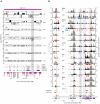Structural variation-associated expression changes are paralleled by chromatin architecture modifications
- PMID: 24265791
- PMCID: PMC3827143
- DOI: 10.1371/journal.pone.0079973
Structural variation-associated expression changes are paralleled by chromatin architecture modifications
Abstract
Copy number variants (CNVs) influence the expression of genes that map not only within the rearrangement, but also to its flanks. To assess the possible mechanism(s) underlying this "neighboring effect", we compared intrachromosomal interactions and histone modifications in cell lines of patients affected by genomic disorders and control individuals. Using chromosome conformation capture (4C-seq), we observed that a set of genes flanking the Williams-Beuren Syndrome critical region (WBSCR) were often looping together. The newly identified interacting genes include AUTS2, mutations of which are associated with autism and intellectual disabilities. Deletion of the WBSCR disrupts the expression of this group of flanking genes, as well as long-range interactions between them and the rearranged interval. We also pinpointed concomitant changes in histone modifications between samples. We conclude that large genomic rearrangements can lead to chromatin conformation changes that extend far away from the structural variant, thereby possibly modulating expression globally and modifying the phenotype.
Geo series accession number: GSE33784, GSE33867.
Conflict of interest statement
Figures


References
-
- Henrichsen CN, Vinckenbosch N, Zollner S, Chaignat E, Pradervand S, et al. (2009) Segmental copy number variation shapes tissue transcriptomes. Nat Genet 41: 424–429. - PubMed
Publication types
MeSH terms
Substances
Associated data
- Actions
- Actions
LinkOut - more resources
Full Text Sources
Other Literature Sources
Molecular Biology Databases

